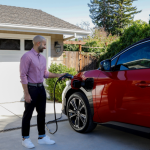The electric vehicle (EV) market has surged in recent years, with global EV sales reaching record highs in 2024. As more consumers switch to electric cars, the demand for reliable and accessible charging infrastructure is skyrocketing. This has led businesses, property owners, and entrepreneurs to consider investing in EV charging stations. But the critical question remains: Are EV charging stations profitable? This article provides an in-depth analysis of the profitability of EV charging stations, exploring costs, revenue models, key factors affecting profitability, and real-world examples to help you make an informed decision.

Understanding EV Charging Stations
EV charging stations come in three main types, each with distinct features and use cases:
-
Level 1 Chargers: These use standard 120-volt outlets and are primarily for home use, delivering 2–5 miles of range per hour. Their slow speed makes them less viable for profitable public charging.
-
Level 2 Chargers: Operating on 240-volt power, these are common in commercial spaces, workplaces, and public areas, offering 10–20 miles of range per hour. They strike a balance between cost and speed, making them ideal for public charging.
-
DC Fast Chargers (Level 3): These provide rapid charging, adding up to 150 miles of range per hour. They are perfect for high-traffic locations like highways or urban hubs but come with higher costs.
Understanding these types is crucial, as their installation costs, operational expenses, and revenue potential vary significantly.
Costs of EV Charging Stations
The profitability of EV charging stations hinges on their ability to offset initial installation and ongoing operational costs. Here’s a detailed breakdown:
Initial Installation Costs
-
Level 1 Chargers: Equipment costs around $500, with minimal installation costs if existing outlets are used.
-
Level 2 Chargers: Equipment ranges from $500 to $2,500, with installation costs varying based on required electrical upgrades.
-
DC Fast Chargers: Equipment costs $10,000 to $50,000, and installation may require significant electrical infrastructure upgrades, potentially adding tens of thousands of dollars.
Ongoing Operational Costs
-
Electricity: Typically accounts for 20–30% of revenue, depending on local rates and usage.
-
Maintenance: Regular upkeep ensures equipment reliability, with costs varying by charger type and usage frequency.
-
Software Subscriptions: Network management and remote monitoring tools add to monthly expenses.
Location Impact
Location significantly affects both costs and revenue potential. For instance, installing a DC fast charger in a remote area may require costly grid upgrades, while urban areas with existing infrastructure may have lower installation costs.
Revenue Models for EV Charging Stations
EV charging stations can generate income through various strategies, and the right approach can significantly boost profitability:
-
Pay-Per-Use Charging:
-
Users pay based on electricity consumed, charged per kilowatt-hour (kWh) or per minute.
-
Level 2 chargers typically charge $2–$6 per hour.
-
DC fast chargers charge $0.30–$0.60 per minute.
-
-
Subscription Models:
-
Some networks offer monthly or annual subscriptions, allowing unlimited or discounted charging for a fixed fee, ensuring steady revenue.
-
-
Ancillary Revenue:
-
Charging stations attract EV drivers to nearby businesses (e.g., malls or restaurants), boosting local spending. Studies show charging stations significantly increase nearby business revenue (MIT News, 2024).
-
Digital screens on chargers can display ads, generating additional income.
-
-
Partnerships and Subsidies:
-
Collaborations with brands or utilities can offset costs. For example, property owners may partner with banks or utilities for branding rights in exchange for installation funding (EV Connect, 2024).
-
-
Government Incentives:
-
Many countries offer tax credits, grants, and rebates to support charging infrastructure. The U.S. Inflation Reduction Act provides up to 30% tax credits on installation costs, especially in low-income or rural areas (Pulse Energy, 2024).
-
Key Factors Affecting Profitability
The profitability of EV charging stations depends on several critical factors:
-
Utilization Rate:
-
The percentage of time a charger is in use directly impacts revenue. Higher utilization equals greater profitability.
-
Studies show increasing utilization from 15% to 20% can achieve break-even (McKinsey, 2023).
-
By late 2023, U.S. fast chargers saw average utilization rise from 9% to 18%, with some regions hitting 26% (Intersolar, 2024).
-
-
Pricing Strategy:
-
Optimal pricing is critical. For example, raising per-kWh rates from $0.45 to $0.53 can help achieve break-even (McKinsey, 2023).
-
Dynamic pricing (e.g., higher rates during peak hours) maximizes revenue.
-
-
Location:
-
High-traffic areas like highways, malls, and business districts have higher utilization and revenue.
-
For instance, DC fast chargers in prime locations can generate up to $10,560 monthly, compared to $2,640 in average locations (Pulse Energy, 2024).
-
-
Government Incentives:
-
Subsidies and tax credits significantly reduce upfront and operational costs. The U.S. NEVI program funds up to 80% of project costs along designated corridors through 2026 (McKinsey, 2023).
-
-
Technology Optimization:
-
Advanced software manages pricing, monitors usage, and optimizes operations. Tools like JuiceNet Enterprise enable real-time performance tracking and analytics to enhance profitability (Pulse Energy, 2024).
-
The following table summarizes key profitability factors:
|
Key Factor |
Details |
Data/Examples |
|---|---|---|
|
Utilization Rate |
Percentage of charger usage time; 15% to 20% achieves break-even. 2022 avg: 7.5%; 2023 some areas: 26%. |
15%, 20%, 7.5%, 26% |
|
Pricing |
$0.45–$0.53/kWh achieves break-even; dynamic pricing boosts revenue. |
$0.45/kWh, $0.53/kWh |
|
Electricity Costs |
Accounts for 20–30% of revenue, impacting margins. |
20–30% |
|
Hardware Costs |
DC fast chargers: $45,000–$100,000; installation: $40,000–$150,000. |
$45,000–$100,000, $40,000–$150,000 |
|
Ancillary Revenue |
Retail or ad revenue; gas station convenience stores account for 35% of sales. |
35% sales, $12,000 |
|
Government Incentives |
Inflation Reduction Act: 30% tax credit up to $100,000/charger; NEVI: 80% project funding. |
30%, $100,000, 80% |
|
Location |
High-traffic areas yield more; prime locations: $10,560/month, average: $2,640/month. |
$10,560/month, $2,640/month |
Case Studies and Real-World Examples
Real-world data and studies offer valuable insights into EV charging station profitability:
-
McKinsey Report (2023):
-
Public fast chargers face short- to medium-term profitability challenges due to low utilization. However, increasing utilization from 15% to 20% can achieve break-even.
-
In 2022, fast chargers averaged 7.5% utilization, peaking at 12% in top months. By late 2023, some regions exceeded 20% (McKinsey, 2023).
-
-
EV Connect:
-
Direct customer charging, increased foot traffic, and subsidies drive profitability.
-
A multinational hotel chain saw increased overnight guests and restaurant usage after installing chargers, highlighting ancillary revenue potential (EV Connect, 2024).
-
-
Pulse Energy:
-
In high-traffic areas, DC fast chargers can be used 8 times daily, generating significant revenue.
-
Hybrid pricing (per-kWh plus time-based fees) encourages charger turnover, serving more drivers (Pulse Energy, 2024).
-
-
MIT Study (2024):
-
EV charging stations boost nearby business spending. Data from over 4,000 California chargers showed increased consumer spending in areas with chargers (MIT News, 2024).
-
-
Intersolar (2024):
-
Many public EV charging stations achieved profitability for the first time, with national average utilization at 15% and some states reaching 26% (Intersolar, 2024).
-
These cases demonstrate that strategic location, smart pricing, and incentives can make EV charging stations profitable.
Challenges and Considerations
Despite their potential, EV charging stations face several challenges:
-
High Upfront Costs:
-
DC fast chargers and sites requiring grid upgrades can cost hundreds of thousands of dollars upfront.
-
-
Grid Capacity:
-
Some regions’ grids may not support additional charger loads, necessitating costly upgrades.
-
-
Competition:
-
As more businesses enter the market, competition could intensify, affecting pricing and utilization.
-
-
Market Maturity:
-
In regions with low EV adoption, utilization may be too low for short-term profitability.
-
However, as the EV market grows, these challenges are likely to diminish, and early investors may benefit from first-mover advantages.
Conclusion
The profitability of EV charging stations depends on factors like location, utilization, pricing strategies, and government incentives. While high upfront and operational costs pose challenges, strategic site selection, effective revenue models (e.g., pay-per-use, subscriptions, and ancillary income), and technological optimization can ensure sustainable profits. With the EV market expanding, demand for charging infrastructure will continue to rise, making now an opportune time to invest.
For businesses or individuals considering EV charging stations, thorough market research, understanding local EV adoption rates, and developing a robust business plan are essential. By leveraging the strategies outlined in this article, EV charging stations can not only be profitable but also play a pivotal role in advancing sustainable transportation.


